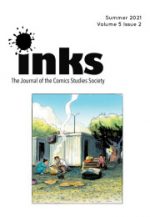The Journal Monitor is a subcategory of the regular Monitor. It is an irregularly published overview of issues of international journals on comics studies as well as special issues on corresponding topics. The introductory texts and/or tables of contents come from the respective websites.
Do you have suggestions or information on new releases that have been overlooked and should be introduced on our website? Please let us know via email: redaktion@comicgesellschaft.de.
→ See previous Monitor posts.
Inks: The Journal of the Comics Studies Society 5.1 & 2
 online via subscription
online via subscription
Website
5.2
- Michelle Ann Abate: “’Sometimes My Hand Shakes So Much I Have to Hold My Wrist to Draw’: Charles M. Schulz and Disability”
- Yosa Vidal: “The Aesthetic and Political Economy of Betrayal in Oesterheld’s Two Versions of The Eternaut I”
- Justin Wigard: “’The Fearless Spaceman Spiff, Interplanetary Explorer Extraordinaire’: Parodic Imagination and the Pulp Aesthetic in Bill Watterson’s Calvin and Hobbes”
- Rik Spanjers, Aimée de Jongh, Kees Ribbens: “’I Am Always Amazed About What I Find Out When I Get on the Ground’: Joe Sacco On, Before, and After the Page”
5.1
- Benjamin Bigelow, Rüdiger Singer: “Introduction: Migration in Twenty-First-Century Documentary Comics”
- Benjamin Bigelow: “Presenting Absence: Migration and Dislocation in Lene Ask’s Dear Rikard (2014)”
- Ning Ma: “Beyond Race: The Monkey King and Creative Polyculturalism in Gene Luen Yang’s American Born Chinese”
- Elizabeth “Biz” Nijdam: “Tying Up Loose Ends: The Fabric of Panel Borders in Kate Evans’ Threads”
- Agnès Schaffauser: “The Wretched of the Sea: Clandestine Immigration and Graphic Artistry in Bessora and Barroux’s Alpha: Abidjan to Gare du Nord”
Journal of Graphic Novels and Comics
 online via subscription
online via subscription
Website
- Emily A. Geest, Ashley R. Knoch, Andrine A. Shufran: “Villainous snakes and heroic butterflies, the moral alignment of animal-themed characters in American superhero comic books”
- N. Yadav: “Whose line is it anyway: graphic anthology drawing the line as a counter to mainstream rape reportage in India”
- Jeffrey A. Brown: “‘I’m too old for this #$&%.’ Old Wolverine and masculinity”
- Anna-Sophie Jürgens, David Tscharke, Jochen Brocks: “From Caligari to Joker: the clown prince of crime’s psychopathic science”
- Philip Smith: “Representations of Israel, literal and allegorical, in X-Men comics”
- Steven W. Holloway, Justina Kaiser, Brian Flota:Re-imagining (black) comic book cataloguing: increasing accessibility through metadata at one university library”
- James Hodapp: “Fashioning Africanfuturism: African comics, Afrofuturism, and Nnedi Okorafor’s Shuri“
- Luis J. Tosina Fernández: “Visual representation of proverbs in comic books and their translation: Asterix as a paradigmatic case”
- Fatemeh Badi-Ozaman, Masoud Sharififar, Mina Zandrahimi: “Analysing the Persian translation of sound effects in comic books by Celotti’s strategies”
- Wajeehah Aayeshah: “Hockey sticks, purple smoke bombs, and empathy: female character representation in Pakistani comics”
- Kalervo A. Sinervo, Ariela Freedman: “Feeling your pain: empathy in comics”
- Raees Calafato, Freda Gudim: “Comics as a multimodal resource and students’ willingness to communicate in Russian”
- Sohini Bera, Rajni Singh: “Appeal for embracing posthumanist perspectives in Orijit Sen’s The River of Stories“
- Harriet Earle: “Traumatic absurdity, palimpsest, and play: A Slaughterhouse-Five case study”
- Natalia Banasik-Jemielniak: “‘Unicorn humour isn’t very subtle.’ Graphic novels and comics as a potential didactic tool for teaching irony to children: the example of Dana Simpson’s Phoebe and her unicorn“
- Betül Gaye Dinç, Ilgım Veryeri Alaca: “Göbeklitepe and Ecological Thinking: Human/Nature Entanglement in Firat Yasa’s Graphic Novel Tepe (The Hill)”
- Manatchai Amponpeerapan, Jaray Singhakowinta: “Confrontations and exchanges of virtue ethics: a study of dialectical friendship between superman and batman in comic books”
- Sandra Rousseau” “Of shapes and sounds : identity and Algerian memory in Nawel Louerrad’s graphic novels”
- Bruce Mutard, Stuart Medley, Helen Kara: “Scholarship in action”
- Kyra Kietrys: “Antonio Altarriba’s El ala rota: remembering a woman hidden in ‘the back room of history’”
- Nicholas Werse: “Framing Religious Violence: Exploring the Paths to Faith and Apostasy in Punk Rock Jesus“
- Partha Bhattacharjee, Priyanka Tripathi, Bidisha Pal: “‘The problem of gender violence in India… was not a legal problem, but a cultural problem’: a conversation with comics creator Ram Devineni”
Studies in Comics 11.2
 print via subscription
print via subscription
Website
- Xosé Pereira Boán:
”Forging intragenerational and common memories: Revisiting Paracuellos’s graphic violence in times of confinement” - Benoît Crucifix: “Jojo, Jimmy and Marie Chairne: What scribbled comics can (not) tell us”
- Keiko Miyajima: “Queering the palate: The erotics and politics of food in Japanese gourmet manga”
- Monica Chiu: “Graphic panelling and the promotion of transnational affiliations in Thien Pham’s Sumo”
- Daniel Pinti: “Panelling without walls: Narrating the border in Barrier”
- Orion Ussner Kidder: “Fire in the jungle: Genocide and colonization in Russell and Pugh’s The Flintstones”
- Amrita Singh: “Photographic silence: Remediating the graphic to visualize migrant experience in Shaun Tan’s The Arrival”
- Christopher A. Crawford, Igor Juricevic: “Understanding pictorial metaphor in comic book covers: A test of the contextual and structural frameworks”
- Chester N. Scoville: “‘She’s practically normal!’: Disability, gender and image in Doom Patrol”
- Dragoş Manea, Mihaela Precup: “‘Who were you crying for?’: Empathy, fantasy and the framing of the perpetrator in Nina Bunjevac’s Bezimena”
- Paul A. Aleixo, Daniel Matkin, Laura Kilby: “What do teachers think about the educational role of comic books?: A qualitative analysis”